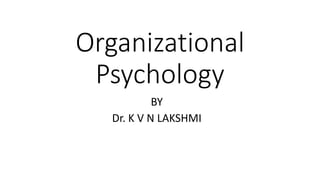This document provides an overview of organizational psychology. It defines psychology and discusses the meaning and impact of psychology. It then moves to discussing organizational psychology specifically. Some key points:
- Organizational psychology studies how organizations affect individual behavior and applies scientific principles to understand what people think and feel within an organization.
- It covers topics like motivation, socialization, and occupational subjects from both an individual and group perspective.
- Organizational psychologists work to understand behavior in organizations and apply insights to improve areas like productivity, job satisfaction, and organizational effectiveness.




















































